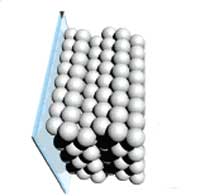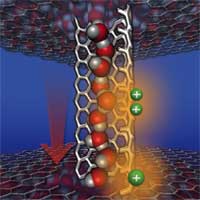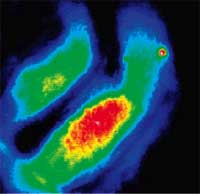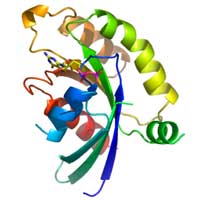Showing Spotlights 2345 - 2352 of 2777 in category All (newest first):
 Some pundits writing about nanotechnology get carried away by their own hype and talk about self-assembly as if bottom-up fabrication technologies, where molecules get assembled into everyday products, are just around the corner. We took a swing at this in our Spotlight from a few days ago (Nanotechnology 'pencil sharpeners' add to researchers' nanofabrication toolbox). Today we bring you another example from the cold reality of the labs that makes clear how early stages this whole field of self-assembly really is. Today, when researchers - with both feet firmly on the ground - talk about self-assembly they mostly talk about template-assisted nanocrystal superlattices in the form of planar thin films. Bottomline is that even the controllable fabrication of highly ordered homogeneous nanostructures on surfaces remains a difficult challenge. And IBM's much touted 'self-assembling nanotechnology' (see: IBM applies self-assembling nanotechnology to conventional chip manufacturing) is nothing more than a patterning process that creates a film with trillions of holes around the on-chip wiring. Moving from a planar geometry of self-assembled nanoscale building blocks such as nanocrystals or nanotubes to a free-standing, three-dimensional multifunctional architecture is not a trivial undertaking. Researchers are just about to make the first steps to such multifunctional (still nanoscale) hierarchical architectures that both retain the properties of the nanocrystals and offer multifunctionality.
Some pundits writing about nanotechnology get carried away by their own hype and talk about self-assembly as if bottom-up fabrication technologies, where molecules get assembled into everyday products, are just around the corner. We took a swing at this in our Spotlight from a few days ago (Nanotechnology 'pencil sharpeners' add to researchers' nanofabrication toolbox). Today we bring you another example from the cold reality of the labs that makes clear how early stages this whole field of self-assembly really is. Today, when researchers - with both feet firmly on the ground - talk about self-assembly they mostly talk about template-assisted nanocrystal superlattices in the form of planar thin films. Bottomline is that even the controllable fabrication of highly ordered homogeneous nanostructures on surfaces remains a difficult challenge. And IBM's much touted 'self-assembling nanotechnology' (see: IBM applies self-assembling nanotechnology to conventional chip manufacturing) is nothing more than a patterning process that creates a film with trillions of holes around the on-chip wiring. Moving from a planar geometry of self-assembled nanoscale building blocks such as nanocrystals or nanotubes to a free-standing, three-dimensional multifunctional architecture is not a trivial undertaking. Researchers are just about to make the first steps to such multifunctional (still nanoscale) hierarchical architectures that both retain the properties of the nanocrystals and offer multifunctionality.
Nov 12th, 2007
 Nanofluidic channels, confining and transporting tiny amounts of fluid, are the pipelines that make the cellular activities of organisms possible. Nanoscale channels carry nutrients into cells and waste from cells and they also transport water into and out of the cell. Body temperature, digestion, reproduction, fluid pressure in the eye, and water conservation in the kidney are only a few of the processes in humans that depend on the proper functioning of cellular water channels. Special proteins called aquaporins can transport water through the cell membrane at a high rate while effectively blocking everything else - even individual protons, the nuclei of hydrogen atoms. The aquaporin channels are so narrow that no molecule larger than water can pass through, effectively forcing them through like beads on a chain. A unique distribution of amino acid residues along the pore wall also accounts for the channel's ability to move water quickly. To keep out molecules smaller than water there is also a chemical filter, formed by the specific orientation and distribution of the amino acid residues lining the pore. Thus water, and only water, flows freely through the aquaporin nanochannels, the direction of flow depending only on changing relative pressure inside and outside the cell. This intriguing mechanism has attracted the attention of nanotechnology researchers who see it as a blueprint for the construction of nanoscale water pumps. A molecular dynamics simulation conducted by Chinese researchers proposes a design for such a molecular pump constructed with a carbon nanotube.
Nanofluidic channels, confining and transporting tiny amounts of fluid, are the pipelines that make the cellular activities of organisms possible. Nanoscale channels carry nutrients into cells and waste from cells and they also transport water into and out of the cell. Body temperature, digestion, reproduction, fluid pressure in the eye, and water conservation in the kidney are only a few of the processes in humans that depend on the proper functioning of cellular water channels. Special proteins called aquaporins can transport water through the cell membrane at a high rate while effectively blocking everything else - even individual protons, the nuclei of hydrogen atoms. The aquaporin channels are so narrow that no molecule larger than water can pass through, effectively forcing them through like beads on a chain. A unique distribution of amino acid residues along the pore wall also accounts for the channel's ability to move water quickly. To keep out molecules smaller than water there is also a chemical filter, formed by the specific orientation and distribution of the amino acid residues lining the pore. Thus water, and only water, flows freely through the aquaporin nanochannels, the direction of flow depending only on changing relative pressure inside and outside the cell. This intriguing mechanism has attracted the attention of nanotechnology researchers who see it as a blueprint for the construction of nanoscale water pumps. A molecular dynamics simulation conducted by Chinese researchers proposes a design for such a molecular pump constructed with a carbon nanotube.
Nov 9th, 2007
 Titanium oxide - due to its versatile optical, electrical and photochemical properties, its relative abundance and low cost, and its non-toxicity - is an important ceramic material with numerous applications as pigments; powders for catalytic or photocatalytic applications; colloids and thin films for photovoltaic, electrochromic, photochromic, electroluminescence devices and sensors; components for antireflecting coatings; or porous membranes for ultrafiltration. Nanocrystalline titania has become a prominent material for dye-sensitized solar cells (DSSCs, also known as 'Grätzel cells' after their inventor), which are photoelectrochemical cells that use photo-sensitization of wide-band-gap mesoporous oxide semiconductors. One major problem with the use of titania in solar cells is that its bandgap does not match that of visible light and titania therefore can only absorb 3-4% of the energy from sunlight. Grätzel cells decrease the bandgap of titania by using dye-absorbed TiO2 nanocrystals as one of the electrodes, resulting in a higher solar energy conversion of 10% or more. Other methods use doping and indeed the application of nitrogen-doped titania as photocatalyst has received increasing attention over the last years because N-doping is found to be particularly effective in decreasing the bandgap of anatase (many of the properties of titania depend on the structure of the TiO2 phase - mainly anatase, brookite and rutile). In order for photocatalysis-based applications to become commercially viable, it will be critical to design low-cost, reproducible, synthetic methods that yield controlled, reproducible, and easy-to-handle nanomaterials processed as coatings with high surface area and high porosity. Researchers in France and Spain now describe for the first time nanostructured coatings that fulfill all these requirements.
Titanium oxide - due to its versatile optical, electrical and photochemical properties, its relative abundance and low cost, and its non-toxicity - is an important ceramic material with numerous applications as pigments; powders for catalytic or photocatalytic applications; colloids and thin films for photovoltaic, electrochromic, photochromic, electroluminescence devices and sensors; components for antireflecting coatings; or porous membranes for ultrafiltration. Nanocrystalline titania has become a prominent material for dye-sensitized solar cells (DSSCs, also known as 'Grätzel cells' after their inventor), which are photoelectrochemical cells that use photo-sensitization of wide-band-gap mesoporous oxide semiconductors. One major problem with the use of titania in solar cells is that its bandgap does not match that of visible light and titania therefore can only absorb 3-4% of the energy from sunlight. Grätzel cells decrease the bandgap of titania by using dye-absorbed TiO2 nanocrystals as one of the electrodes, resulting in a higher solar energy conversion of 10% or more. Other methods use doping and indeed the application of nitrogen-doped titania as photocatalyst has received increasing attention over the last years because N-doping is found to be particularly effective in decreasing the bandgap of anatase (many of the properties of titania depend on the structure of the TiO2 phase - mainly anatase, brookite and rutile). In order for photocatalysis-based applications to become commercially viable, it will be critical to design low-cost, reproducible, synthetic methods that yield controlled, reproducible, and easy-to-handle nanomaterials processed as coatings with high surface area and high porosity. Researchers in France and Spain now describe for the first time nanostructured coatings that fulfill all these requirements.
Nov 8th, 2007
 Nanotechnology's poster child, the carbon nanotube (CNT), has been explored for use in many technical applications. Increasingly, researchers are also looking at the unique biological properties of CNTs for potential biomedical uses. For instance, the interaction between DNA and CNTs have been explored and DNA-functionalized nanotubes hold significant promise as nucleic acid sensors. Nanotubes have also been considered for use as scaffolds for cells in tissue engineering. No matter what their intended function, any material used in medicine must exhibit - among other compatibility factors - biocompatibility, non-toxicity and non-carcinogenicity. And here the jury is still out as far as CNTs are concerned. One limiting factor of toxicological studies so far has been the use of animal tissue rather than living specimen. Researchers have now succeeded in detecting single-walled CNTs (SWCNTs) inside living animals - with surprisingly benign results - paving the way for future research on the effects and fate of nanotubes inside living organisms.
Nanotechnology's poster child, the carbon nanotube (CNT), has been explored for use in many technical applications. Increasingly, researchers are also looking at the unique biological properties of CNTs for potential biomedical uses. For instance, the interaction between DNA and CNTs have been explored and DNA-functionalized nanotubes hold significant promise as nucleic acid sensors. Nanotubes have also been considered for use as scaffolds for cells in tissue engineering. No matter what their intended function, any material used in medicine must exhibit - among other compatibility factors - biocompatibility, non-toxicity and non-carcinogenicity. And here the jury is still out as far as CNTs are concerned. One limiting factor of toxicological studies so far has been the use of animal tissue rather than living specimen. Researchers have now succeeded in detecting single-walled CNTs (SWCNTs) inside living animals - with surprisingly benign results - paving the way for future research on the effects and fate of nanotubes inside living organisms.
Nov 7th, 2007
 Proteins, large organic compounds made of amino acids, provide many of the most basic units of function in living systems. They make up about half of the dry mass of animals and humans. There may be as many as 1 million different types of proteins in the human body (it is estimated that the human proteome is comprised of an average of 5-7 protein isoforms per open reading frame in the human genome and a further 600 000-odd immunoglobulins present in serum at any given moment) - nobody really knows. The word protein comes from the Greek prota, meaning 'of primary importance', and they actually may become of great importance in nanoscale fabrication as well. Proteins have an amazing number of functions inside our bodies: Enzymes serve as catalysts to break down food into various components; transport proteins such as hemoglobin transport molecules (e.g. oxygen); storage proteins store molecules (e.g. iron is stored in the liver as a complex with the protein ferritin); structural proteins such as keratin or collagen are needed for mechanical support in tissues like cartilage and skin but also hair and nails; proteins are the major component of muscles and for instance actin or myosin are key to contracting muscle fibers; hormones control the growth of cells and their differentiation; antibody proteins are needed for immune protection; and toxins are, well, toxic, but in minute amounts could have beneficial medical properties. Scientists believe that this variety of natural protein functions - actuation, catalysis, structural transport and molecular sequestering - could serve as valuable and versatile building blocks for synthesis of functional materials. Researchers now have found that nanometer-scale changes in protein conformation can be translated into macroscopic changes in material properties. The result is a new class of dynamic, protein-based materials.
Proteins, large organic compounds made of amino acids, provide many of the most basic units of function in living systems. They make up about half of the dry mass of animals and humans. There may be as many as 1 million different types of proteins in the human body (it is estimated that the human proteome is comprised of an average of 5-7 protein isoforms per open reading frame in the human genome and a further 600 000-odd immunoglobulins present in serum at any given moment) - nobody really knows. The word protein comes from the Greek prota, meaning 'of primary importance', and they actually may become of great importance in nanoscale fabrication as well. Proteins have an amazing number of functions inside our bodies: Enzymes serve as catalysts to break down food into various components; transport proteins such as hemoglobin transport molecules (e.g. oxygen); storage proteins store molecules (e.g. iron is stored in the liver as a complex with the protein ferritin); structural proteins such as keratin or collagen are needed for mechanical support in tissues like cartilage and skin but also hair and nails; proteins are the major component of muscles and for instance actin or myosin are key to contracting muscle fibers; hormones control the growth of cells and their differentiation; antibody proteins are needed for immune protection; and toxins are, well, toxic, but in minute amounts could have beneficial medical properties. Scientists believe that this variety of natural protein functions - actuation, catalysis, structural transport and molecular sequestering - could serve as valuable and versatile building blocks for synthesis of functional materials. Researchers now have found that nanometer-scale changes in protein conformation can be translated into macroscopic changes in material properties. The result is a new class of dynamic, protein-based materials.
Nov 6th, 2007
 Animals that cling to walls and walk on ceilings owe this ability to micro- and nanoscale attachment elements. The highest adhesion forces are encountered in geckos. For centuries, the ability of geckos to climb any vertical surface or hang from ceilings with one toe has always generated considerable interest. A gecko is the heaviest animal that can 'stand' on a ceiling, with its feet over its head. This is why scientists are intensely researching the adhesive system of the tiny hairs on its feet. On the sole of a gecko's toes there are some one billion tiny adhesive hairs called setae (3-130 micrometers in length), splitting into even smaller spatulae (about 200 nanometers in both width and length) at the end. It was found that these elastic hairs induce strong van der Waals forces. This finding has prompted many researchers to use synthetic microarrays to mimic gecko feet. Recent work, mainly from A. Dhinojwala, P.M. Ajayan, M. Meyyappan, and L. Dai groups, as well as the Max Planck Institute for Metals Research in Germany (see our previous Spotlight: Gecko nanotechnology), has indicated that aligned carbon nanotubes (CNTs) sticking out of substrate surfaces showed strong nanometer-scale adhesion forces. Although carbon nanotubes are thousands of times thinner than a human hair, they can be stronger than steel, lighter than plastic, more conductive than copper for electricity and diamond for heat. Applications of such bio-inspired development of artificial dry adhesive systems with aligned carbon nanotubes could range from low-tech fridge magnets to holding together electronics or even airplane parts.
Animals that cling to walls and walk on ceilings owe this ability to micro- and nanoscale attachment elements. The highest adhesion forces are encountered in geckos. For centuries, the ability of geckos to climb any vertical surface or hang from ceilings with one toe has always generated considerable interest. A gecko is the heaviest animal that can 'stand' on a ceiling, with its feet over its head. This is why scientists are intensely researching the adhesive system of the tiny hairs on its feet. On the sole of a gecko's toes there are some one billion tiny adhesive hairs called setae (3-130 micrometers in length), splitting into even smaller spatulae (about 200 nanometers in both width and length) at the end. It was found that these elastic hairs induce strong van der Waals forces. This finding has prompted many researchers to use synthetic microarrays to mimic gecko feet. Recent work, mainly from A. Dhinojwala, P.M. Ajayan, M. Meyyappan, and L. Dai groups, as well as the Max Planck Institute for Metals Research in Germany (see our previous Spotlight: Gecko nanotechnology), has indicated that aligned carbon nanotubes (CNTs) sticking out of substrate surfaces showed strong nanometer-scale adhesion forces. Although carbon nanotubes are thousands of times thinner than a human hair, they can be stronger than steel, lighter than plastic, more conductive than copper for electricity and diamond for heat. Applications of such bio-inspired development of artificial dry adhesive systems with aligned carbon nanotubes could range from low-tech fridge magnets to holding together electronics or even airplane parts.
Nov 5th, 2007
 Nanotechnologies opened a new door towards the development of novel techniques and devices for probing biological systems such as biomolecules and single cells. The most reliable bioprobes today rely on fluorescent or radioactive labeling. Phosphorescent emitters are preferable for use in sensing or biological labeling schemes because the emission occurs over a very long timescale (for nanoscientists, 'very long timescale' is a relative term; here we are talking about 1 microsecond). Especially semiconductor nanocrystals (quantum dots) possess several properties that make them very attractive for fluorescent tagging: broad excitation spectrum, narrow emission spectrum, precise tunability of their emission peak, longer fluorescence lifetime than organic fluorophores and negligible photobleaching. Scientists have discovered that these nanocrystals can enable researchers to study cell processes at the level of a single molecule and may significantly improve the diagnosis and treatment of diseases such as cancers. However, the band gap of most emissive semiconductors, with the exception of cadmium-containing materials, is either too high or too low to easily make visible emitting quantum dots. Unfortunately, cadmium is quite toxic and therefore not really suitable for medical applications. In a step towards circumventing the issues with cadmium toxicity, researchers have make progress in demonstrating visible phosphorescence from doped nanocrystal systems. A recent example is the synthesis of a nanoscopic material composed of the non-toxic elements zinc, selenium, sulfur and manganese which displays efficient visible emission.
Nanotechnologies opened a new door towards the development of novel techniques and devices for probing biological systems such as biomolecules and single cells. The most reliable bioprobes today rely on fluorescent or radioactive labeling. Phosphorescent emitters are preferable for use in sensing or biological labeling schemes because the emission occurs over a very long timescale (for nanoscientists, 'very long timescale' is a relative term; here we are talking about 1 microsecond). Especially semiconductor nanocrystals (quantum dots) possess several properties that make them very attractive for fluorescent tagging: broad excitation spectrum, narrow emission spectrum, precise tunability of their emission peak, longer fluorescence lifetime than organic fluorophores and negligible photobleaching. Scientists have discovered that these nanocrystals can enable researchers to study cell processes at the level of a single molecule and may significantly improve the diagnosis and treatment of diseases such as cancers. However, the band gap of most emissive semiconductors, with the exception of cadmium-containing materials, is either too high or too low to easily make visible emitting quantum dots. Unfortunately, cadmium is quite toxic and therefore not really suitable for medical applications. In a step towards circumventing the issues with cadmium toxicity, researchers have make progress in demonstrating visible phosphorescence from doped nanocrystal systems. A recent example is the synthesis of a nanoscopic material composed of the non-toxic elements zinc, selenium, sulfur and manganese which displays efficient visible emission.
Nov 2nd, 2007
 Granted, they don't sell them at Gap yet, but if current research undertaken by scientists in Australia is any indication, bullet-proof vests as light as T-shirts could become reality in the not too-distant future. Carbon nanotubes (CNTs) have great potential applications in making ballistic-resistance materials. The remarkable properties of CNTs makes them an ideal candidate for reinforcing polymers and other materials, and could lead to applications such as ligh-weight bullet-proof vests or shields for military vehicles and spacecraft. For these applications, thinner, lighter, and more flexible materials with superior dynamic mechanical properties are required than what is currently available. Ongoing research at the University of Sydney explores the energy absorption capacity of single-walled carbon nanotubes under a ballistic impact. CNT reinforced materials might not only be very effective in stopping ballistic penetration or high speed impact, like Kevlar vests, but they might also be able to prevent the blunt force trauma that still is a problem with today's body armor.
Granted, they don't sell them at Gap yet, but if current research undertaken by scientists in Australia is any indication, bullet-proof vests as light as T-shirts could become reality in the not too-distant future. Carbon nanotubes (CNTs) have great potential applications in making ballistic-resistance materials. The remarkable properties of CNTs makes them an ideal candidate for reinforcing polymers and other materials, and could lead to applications such as ligh-weight bullet-proof vests or shields for military vehicles and spacecraft. For these applications, thinner, lighter, and more flexible materials with superior dynamic mechanical properties are required than what is currently available. Ongoing research at the University of Sydney explores the energy absorption capacity of single-walled carbon nanotubes under a ballistic impact. CNT reinforced materials might not only be very effective in stopping ballistic penetration or high speed impact, like Kevlar vests, but they might also be able to prevent the blunt force trauma that still is a problem with today's body armor.
Nov 1st, 2007
 Some pundits writing about nanotechnology get carried away by their own hype and talk about self-assembly as if bottom-up fabrication technologies, where molecules get assembled into everyday products, are just around the corner. We took a swing at this in our Spotlight from a few days ago (Nanotechnology 'pencil sharpeners' add to researchers' nanofabrication toolbox). Today we bring you another example from the cold reality of the labs that makes clear how early stages this whole field of self-assembly really is. Today, when researchers - with both feet firmly on the ground - talk about self-assembly they mostly talk about template-assisted nanocrystal superlattices in the form of planar thin films. Bottomline is that even the controllable fabrication of highly ordered homogeneous nanostructures on surfaces remains a difficult challenge. And IBM's much touted 'self-assembling nanotechnology' (see: IBM applies self-assembling nanotechnology to conventional chip manufacturing) is nothing more than a patterning process that creates a film with trillions of holes around the on-chip wiring. Moving from a planar geometry of self-assembled nanoscale building blocks such as nanocrystals or nanotubes to a free-standing, three-dimensional multifunctional architecture is not a trivial undertaking. Researchers are just about to make the first steps to such multifunctional (still nanoscale) hierarchical architectures that both retain the properties of the nanocrystals and offer multifunctionality.
Some pundits writing about nanotechnology get carried away by their own hype and talk about self-assembly as if bottom-up fabrication technologies, where molecules get assembled into everyday products, are just around the corner. We took a swing at this in our Spotlight from a few days ago (Nanotechnology 'pencil sharpeners' add to researchers' nanofabrication toolbox). Today we bring you another example from the cold reality of the labs that makes clear how early stages this whole field of self-assembly really is. Today, when researchers - with both feet firmly on the ground - talk about self-assembly they mostly talk about template-assisted nanocrystal superlattices in the form of planar thin films. Bottomline is that even the controllable fabrication of highly ordered homogeneous nanostructures on surfaces remains a difficult challenge. And IBM's much touted 'self-assembling nanotechnology' (see: IBM applies self-assembling nanotechnology to conventional chip manufacturing) is nothing more than a patterning process that creates a film with trillions of holes around the on-chip wiring. Moving from a planar geometry of self-assembled nanoscale building blocks such as nanocrystals or nanotubes to a free-standing, three-dimensional multifunctional architecture is not a trivial undertaking. Researchers are just about to make the first steps to such multifunctional (still nanoscale) hierarchical architectures that both retain the properties of the nanocrystals and offer multifunctionality.
 Subscribe to our Nanotechnology Spotlight feed
Subscribe to our Nanotechnology Spotlight feed





